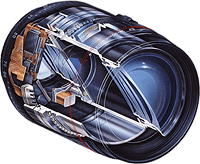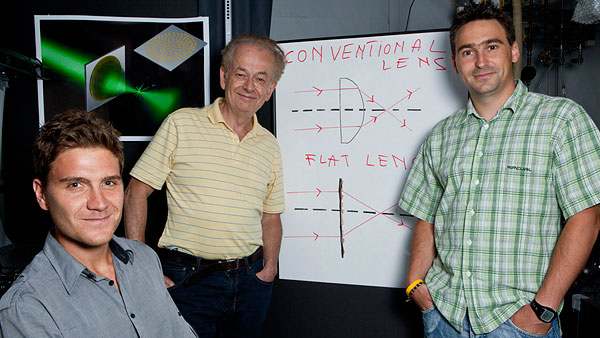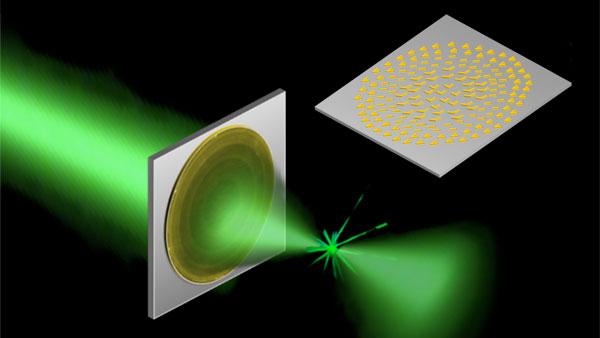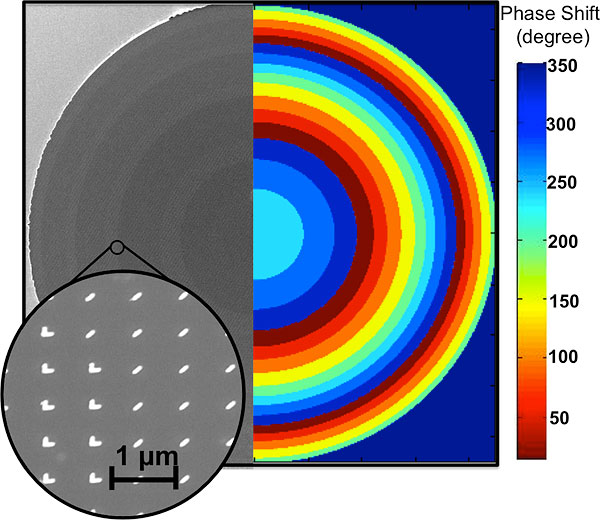Fact Check: Flat camera lenses, miracle or miscue?
posted Wednesday, September 5, 2012 at 2:30 PM EST
 Early last week, stories began to circulate the web of a development that some claimed would spell the end of bulky lenses for everything from camera phones to digital SLRs, while simultaneously and radically improving image quality. Press outlets around the world worked to outdo each other with ever-more exuberant interpretations of its impact. The resulting coverage offers a useful example of how the pursuit of gee-whiz headlines often sacrifices accuracy or even understanding in the process.
Early last week, stories began to circulate the web of a development that some claimed would spell the end of bulky lenses for everything from camera phones to digital SLRs, while simultaneously and radically improving image quality. Press outlets around the world worked to outdo each other with ever-more exuberant interpretations of its impact. The resulting coverage offers a useful example of how the pursuit of gee-whiz headlines often sacrifices accuracy or even understanding in the process.
A typical example comes from Britain's Daily Mail newspaper, which breathlessly exclaimed that the research at Harvard University could "revolutionise everything from professional and smartphone photography to fibre-optic cables ... as lenses need be bulky no longer", while Wired speculated that "camera lenses might look radically different in a couple years thanks to [the] new technology". Some went even further; several sites such as Ubergizmo suggested that "such paper-thin lenses may equip the smartphones of the future with DSLR capabilities". That'd certainly be nice if true, but does anything in the underlying story make this seem likely?

Photo courtesy of Harvard SEAS / Eliza Grinnell.
The news hailed from a press release issued a couple of weeks ago by the Harvard School of Engineering and Applied Sciences. When we first stumbled on the story a couple of days later on Slashdot, it struck us as intriguing and so we did a little digging for ourselves. The research suggested to us that while certainly interesting in a non-photographic context, the announcement had been widely misinterpreted, and so we passed on the story. Days later, though, we continue to see reports on the research, with many articles repeating the assertion that a revolution is just around the corner, ready to reshape photography as we know it. We've also been receiving emails from readers who've seen these articles, and were thrilled at the prospect of being able to leave all of their bulky glass at home.
In short, the creation at the heart of the Harvard announcement consists of a thin silicon wafer on which is layered a nanometer of gold. The gold surface is etched to leave behind only a fine pattern of V-shaped structures, evenly spaced with sub-wavelength periodicity across the surface of the wafer. These act as optical antennas that change the direction of incoming light. That is, they're electromagnetic antennas that operate at wavelengths as short as those of infrared and even visible light. The V-shaped structures are varied across the surface of the wafer to focus the incoming light as needed. The result? A flat surface that focuses light much like a glass lens would, but with an important difference: monochromatic aberrations such as astigmatism and coma are eliminated. A glass lens would require multiple elements to correct for these aberrations, increasing size, weight, and complexity.

Rendering courtesy of Harvard SEAS / Francesco Aieta.
So... why did we pass on the story at the time, and why the change of heart now? We were struck by a few key points in researching the article last week:
-
You might have noted that we referred to monochromatic aberrations. That's because the design of the lens is tuned for one specific wavelength of light. Although the press release states that the design is "completely scalable", tuning for a different wavelength requires adjusting the size, angle, and spacing of the gold nanoantenna structures.
-
Harvard also notes that the design scales from near-infrared to terahertz wavelengths. Visible light falls outside of that range, and while the paper suggests it might be possible to extend the design to the visible, that redesign may not prove worthwhile. The paper itself acknowledges this, stating that the technology is "particularly interesting in the mid-infrared, the terahertz and those ranges of frequencies where transparent refractive materials are harder to find compared to the near-infrared and the visible". In other words, for near-infrared and visible light, adapting the design is less attractive because we already have suitable transparent refractive materials--glass, crystals, plastic, etc.--which can do the job for us, and we have experience in using them.
-
Also worth noting is the fragility of a 60 nanometer-thick silicon lens. Consider that standard plastic wrap such as you might use for covering your food leftovers is, according to Wikipedia, about 12.5 microns in thickness. That's still a couple of hundred times thicker than the silicon wafer of Harvard's flat lens. That might be fine in the lab or in a carefully-controlled environment, but it's not going to stand up to unprotected life in a pocket or camera bag. Hence you're still going to need to layer the wafer behind (or perhaps sandwich it with) another transparent material. Guess what? You've got the glass back in your lens, even if it's flat-surfaced, and not present in quite the same quantity as current lenses.
-
All of that, unfortunately, pales in comparison to the final point. According to the paper, the experimental design is tuned for near-infrared light at 1.55µm wavelength, where it has an efficiency of just 10%. That is to say, 90% of the incoming light is lost to absorption, reflections inside the substrate, and optical losses. These losses, says the paper, can be reduced, but that's offset by the fact that redesigning the structure for visible light will in itself increase losses. It isn't clear just what the maximum attainable efficiency for visible light would be, but this appears to be the real killer for the technology, at least in so far as its application to traditional photography and videography.

Image courtesy of Harvard SEAS / Francesco Aieta.
None of this means the research isn't valuable. On the contrary, there are likely fields where it's of significant use--light-gathering efficiency isn't the most important metric for every application, and the new approach could be particularly useful in telecommunications. The combination of these hurdles, though, suggests to us that it's very unlikely we'll be seeing flat lenses based on this research appearing in our cameras or camera phones in the near future.
Unfortunately, as is too often the case, much of the media seems to have rushed for the figurative presses with an attention-grabbing story, rather than taking the time to understand the obstacles faced by the technology. With the challenges of deadlines and budgets, that's maybe understandable, but we felt obligated to temper the enthusiasm just a little, with a closer look at the reasons why your camera's lens won't likely be going on a miracle diet any time soon.
(Cutaway image of Canon EF 28-80mm f/2.8-4L USM lens courtesy of Canon)